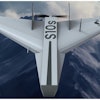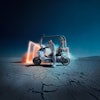The U.S. Air Force’s McKinley Climatic Laboratory at Elgin Air Force Base in Florida is one of those places that has literally seen it all, including an explosion last month reportedly caused by highly pressurized refrigerants used for cold weather simulations.
In total, the lab boasts six testing chambers that can simulate conditions from -80 to 170 degrees Fahrenheit, rainfall as great as 15”/hour, winds as high as 70 miles/hour and elevations as great as 80,000’. These chambers can also simulate ice, snow and sand storms – transitioning from a variety of conditions in a matter of hours.
Part of the 96th Test Wing, the 55,000-square foot lab is used by the Air Force, other U.S. and foreign agencies, as well as private companies including Google, Ford, Airbus and others. One of the more recent inhabitants of the chambers has been the highly touted F-35 fighter jet, which recently took part in some extreme engine testing. Boeing has also done work on its 787 Dreamliner at the facility.
However, its inhabitants are not exclusive to those that fly. An equipment testing chamber can be used for tanks, cars and other equipment. Ford, for example recently used the facility to test its trucks in extreme winter conditions.
Also, different aircraft operations can be performed there, like running the aircraft under extreme thermal loads to test environmental control systems and cooling capacities.
The facility was built in 1947 as part of an initiative to take testing out of the natural elements and into an environment that could be manipulated to simulate more extreme conditions. The facility is named after the person who proposed building it – Colonel Ashley McKinley.
As you can imagine, the building is engineered in as extreme a manner as the tests it conducts. This includes a floor composed of 25’ wide, 12” thick cement slabs, walls and doors insulated with 13” of glass-wool board sheathed in galvanized steel, and foam-rubber sealed doors. The ceiling is insulated on a corrugated steel deck suspended from the roof trusses by chains.
Even more extreme – operational costs of the facility. It reportedly generates an electric bill close to $200,000/month. To help offset those costs, companies wishing to use the facility pay between $10,000 and $25,000 a day.






















